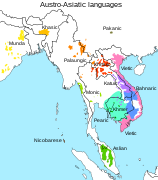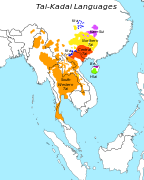南方大语系
外观
| 南方大语系 | |
|---|---|
| 有争议 | |
| 地理分布 | 台湾、东南亚、南亚、马达加斯加、大洋洲 |
| 谱系学分类 | 世界主要语系之一(有争议) |
| 分支 |
苗瑶语系(有争议)
汉藏语系(有争议)
阿伊努语(有争议)
尼哈利语(有争议)
日琉语系(有争议)
|
| – | |
 南方大语系分布图 | |
南方大语系(英语:Austric languages),又称南方语系、南方语门,或音译为奥斯垂克诸语,是一个有争议的构想大语系,其认为位在东亚的台湾、非洲的马达加斯加,以及东南亚、大洋洲的南岛语系,以及位于东南亚、南亚的南亚语系、中国西南的壮侗语系彼此间有关联,属于一个更大的语系。在一些学者版本中,还包含了中国西南的苗瑶语系,甚至还包含东亚的汉藏语系,还有孤立语言阿伊努语跟尼哈利语。
历史
[编辑]南方大语系的假设首先由德国传教士威廉·施密特(Wilhelm Schmidt)于1906年提出。他试图用音系学、词法学和词汇语义的证据证明南亚语系和南岛语系属于一个南方大语系。[1][a]施密特的假设在东南亚语言专家间的接受度参差不齐,在接下来几个十年收获的关注微乎其微。[2]:697
南方大语系的研究在20世纪晚期重新受到关注,[3]臻极于La Vaughn H. Hayes的一系列论文,他给出了原始南方语词表和原始南方语音系;[4]Lawrence Reid则专注于形态证据。[5]
证据
[编辑]Reid (2005)列出原始南亚语和原始南岛语下列“可能的”同源词。[6]:150–151
| 词义 | 灰 | 狗 | 蛇 | 腹 | 目 | 父 | 母 | 腐烂 | 买 |
|---|---|---|---|---|---|---|---|---|---|
| 原始南亚语 | *qabuh | *cu(q) | *[su](l̩)aR | *ta?al/*ti?al | *mə(n)ta(q) | *(qa)ma(ma) | *(na)na | *ɣok | *pə[l̩]i |
| 原始南岛语 | *qabu | *asu | *SulaR | *tiaN | *maCa | *t-ama | *t-ina | *ma-buRuk | *beli |
- 前缀*pa-“使役”(原始南亚语、原始南岛语)
- 中缀*-um-“施事格”(原始南亚语、原始南岛语)
- 中缀*-in-“工具格”(原始南亚语)、“名词化”(原始南岛语)
分类
[编辑]| 南方大语系 |
| ||||||||||||||||||
- 谢尔盖·阿纳托利耶维奇·斯塔罗斯金采用了另一个分法,将南方大语系分为两大分支,并认为南方大语系和得内-高加索语系组成更大的一个语系“得内-傣超语系”。[7]:309
| 得内‑傣超语系 |
| |||||||||||||||||||||||||||
| 南岛‑傣超语系 |
| |||||||||||||||||||||
分布图
[编辑]注释
[编辑]- ^ “南亚语系”和“南岛语系”其实都是施密特创造的。以前通用的名称“孟高棉”和“马来-波利尼西亚”虽然仍在使用,但适用范围比“南亚语系”和“南岛语系”小得多。
脚注
[编辑]- ^ Schmidt (1906).
- ^ Blust (2013).
- ^ Shorto (1976), Diffloth (1990), Diffloth (1994).
- ^ Hayes (1992), Hayes (1997), Hayes (1999), Hayes (2000), Hayes (2001).
- ^ Reid (1994), Reid (1999), Reid (2005).
- ^ 6.0 6.1 Reid (2005).
- ^ van Driem, George. Sino-Austronesian vs. Sino-Caucasian, Sino-Bodic vs. Sino-Tibetan, and Tibeto-Burman as default theory (PDF). Yadava, Yogendra P. (编). Contemporary Issues in Nepalese Linguistics. Linguistic Society of Nepal. 2005: 285–338 [2016-11-08]. ISBN 978-99946-57-69-8. (原始内容 (PDF)存档于2011-07-26).
- ^ Alexander Vovin. Proto-Japanese beyond the accent system. Current Issues in Linguistic Theory. [2017-01-16]. (原始内容存档于2018-05-11).
参考文献
[编辑]- Benedict, Paul K. 1976. Austro-Thai and Austroasiatic. In: Philip N. Jenner, Laurence C. Thompson, and Stanley Starosta, eds., Austroasiatic Studies, Part I, pp. 1–36. Honolulu: University of Hawai‘i Press.
- Blazhek, Vaclav. 2000. Comments on Hayes "The Austric Denti-alveolar Sibilants". Mother Tongue V:15-17.
- Blevins, Juliette (2007). "A Long Lost Sister of Proto-Austronesian? Proto-Ongan, Mother of Jarawa and Onge of the Andaman Islands". Oceanic Linguistics 46 (1): 154–198.
- Blust, Robert. 1996. Beyond the Austronesian homeland: The Austric hypothesis and its implications for archaeology. In: Prehistoric Settlement of the Pacific, ed. by Ward H.Goodenough, ISBN 978-0-87169-865-0 DIANE Publishing Co, Collingdale PA, 1996, pp. 117-137. (Transactions of the American Philosophical Society 86.5. (Philadelphia: American Philosophical Society).
- Blust, Robert. 2000. Comments on Hayes, "The Austric Denti-alveolar Sibilants". Mother Tongue V:19-21.
- Blust, Robert. The Austronesian Languages revised. Australian National University. 2013. ISBN 978-1-922185-07-5. hdl:1885/10191.
- Diffloth, Gerard F. 1989. What Happened to Austric? Mon–Khmer Studies XVI-XVII:1-9.
- Diffloth, Gerard. 1994. The lexical evidence for Austric so far. Oceanic Linguistics 33(2):309-321.
- Fleming, Hal. 2000. LaVaughn Hayes and Robert Blust Discuss Austric. Mother Tongue V:29-32.
- Hayes, La Vaughn H. 1992. On the Track of Austric, Part I: Introduction. Mon–Khmer Studies XXI:143-77.
- Hayes, La Vaughn H. 1997. On the Track of Austric, Part II: Consonant Mutation in Early Austroasiatic. Mon–Khmer Studies XXVII:13-41.
- Hayes, La Vaughn H. 1999. On the Track of Austric, Part III: Basic Vocabulary Correspondence. Mon–Khmer Studies XXIX:1-34.
- Hayes, La Vaughn H. 2000. The Austric Denti-alveolar Sibilants. Mother Tongue V:1-12.
- Hayes, La Vaughn H. 2000. Response to Blazhek's Comments. Mother Tongue V:33-4.
- Hayes, La Vaughn H. 2000. Response to Blust's Comments. Mother Tongue V:35-7.
- Hayes, La Vaughn H. 2000. Response to Fleming's Comments. Mother Tongue V:39-40.
- Hayes, La Vaughn H. 2001. On the Origin of Affricates in Austric. Mother Tongue VI:95-117.
- Hayes, La Vaughn H. 2001. Response to Sidwell. Mother Tongue VI:123-7.
- Reid, Lawrence A. 1994. Morphological evidence for Austric. Oceanic Linguistics 33(2):323-344.
- Reid, Lawrence A. 1996. The current state of linguistic research on the relatedness of the language families of East and Southeast Asia. In: Ian C. Glover and Peter Bellwood, editorial co-ordinators, Indo-Pacific Prehistory: The Chiang Mai Papers, Volume 2, pp . 87-91. Bulletin of the Indo-Pacific Prehistory Association 15. Canberra: Australian National University.
- Reid, Lawrence A. 1999. New linguistic evidence for the Austric hypothesis. In Selected Papers from the Eighth International Conference on Austronesian Linguistics, ed. by Elizabeth Zeitoun and Paul Jen-kuei Li, pp. 5–30. Taipei: Academia Sinica.
- ———. The current status of Austric: A review and evaluation of the lexical and morphosyntactic evidence. Sagart, Laurent; Blench, Roger; Sanchez-Mazas, Alicia (编). The peopling of East Asia: putting together archaeology, linguistics and genetics. London: Routledge Curzon. 2005. hdl:10125/33009.
- Schmidt, Wilhelm. Die Mon–Khmer-Völker, ein Bindeglied zwischen Völkern Zentralasiens und Austronesiens ('[The Mon–Khmer Peoples, a Link between the Peoples of Central Asia and Austronesia'). Archiv für Anthropologie. 1906, 5: 59–109.
- Schmidt, Wilhelm. 1930. Die Beziehungen der austrischen Sprachen zum Japanischen [The Connections of the Austric Languages to Japanese]. Wien Beitrag zur Kulturgeschichte und Linguistik 1:239-51.
- Shorto, H. L. 1976. In Defense of Austric. Computational Analyses of Asian and African Languages 6:95-104.
- Sidwell, Paul. 2001. Comments on La Vaughn H. Hayes' "On the Origin of Affricates in Austric". Mother Tongue VI:119-121.
- Van Driem, George. 2000. Four Austric Theories. Mother Tongue V:23-27.








